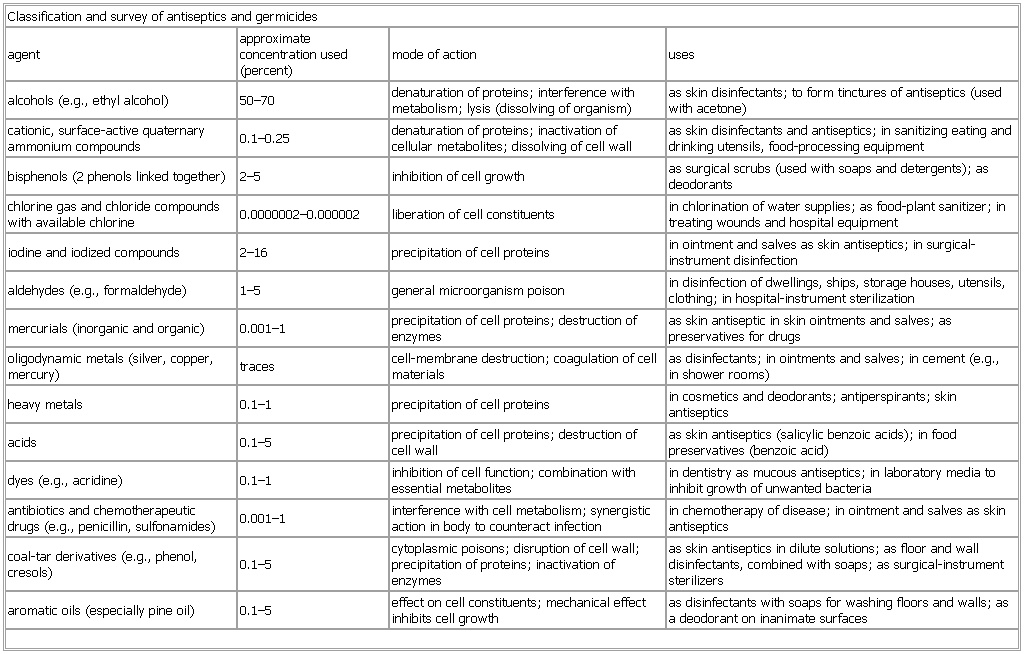- Classification and survey of antiseptics and germicides
-
▪ TableClassification and survey of antiseptics and germicidesalcohols (e.g., ethyl alcohol) 50–70 denaturation of proteins; interference with metabolism; lysis (dissolving of organism) as skin disinfectants; to form tinctures of antiseptics (used with acetone)cationic, surface-active quaternary ammonium compounds 0.1–0.25 denaturation of proteins; inactivation of cellular metabolites; dissolving of cell wall as skin disinfectants and antiseptics; in sanitizing eating and drinking utensils, food-processing equipmentbisphenols (2 phenols linked together) 2–5 inhibition of cell growth as surgical scrubs (used with soaps and detergents); as deodorantschlorine gas and chloride compounds with available chlorine 0.0000002–0.000002 liberation of cell constituents in chlorination of water supplies; as food-plant sanitizer; in treating wounds and hospital equipmentiodine and iodized compounds 2–16 precipitation of cell proteins in ointment and salves as skin antiseptics; in surgical-instrument disinfectionaldehydes (e.g., formaldehyde) 1–5 general microorganism poison in disinfection of dwellings, ships, storage houses, utensils, clothing; in hospital-instrument sterilizationmercurials (inorganic and organic) 0.001–1 precipitation of cell proteins; destruction of enzymes as skin antiseptic in skin ointments and salves; as preservatives for drugsoligodynamic metals (silver, copper, mercury) traces cell-membrane destruction; coagulation of cell materials as disinfectants; in ointments and salves; in cement (e.g., in shower rooms)heavy metals 0.1–1 precipitation of cell proteins in cosmetics and deodorants; antiperspirants; skin antisepticsacids 0.1–5 precipitation of cell proteins; destruction of cell wall as skin antiseptics (salicylic benzoic acids); in food preservatives (benzoic acid)dyes (e.g., acridine) 0.1–1 inhibition of cell function; combination with essential metabolites in dentistry as mucous antiseptics; in laboratory media to inhibit growth of unwanted bacteriaantibiotics and chemotherapeutic drugs (e.g., penicillin, sulfonamides) 0.001–1 interference with cell metabolism; synergistic action in body to counteract infection in chemotherapy of disease; in ointment and salves as skin antisepticscoal-tar derivatives (e.g., phenol, cresols) 0.1–5 cytoplasmic poisons; disruption of cell wall; precipitation of proteins; inactivation of enzymes as skin antiseptics in dilute solutions; as floor and wall disinfectants, combined with soaps; as surgical-instrument sterilizersaromatic oils (especially pine oil) 0.1–5 effect on cell constituents; mechanical effect inhibits cell growth as disinfectants with soaps for washing floors and walls; as a deodorant on inanimate surfacesSee as table:

* * *
Universalium. 2010.
